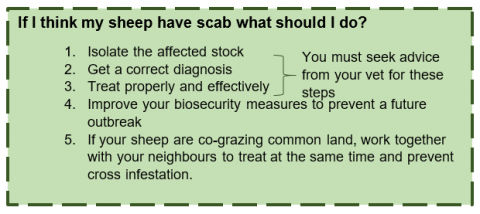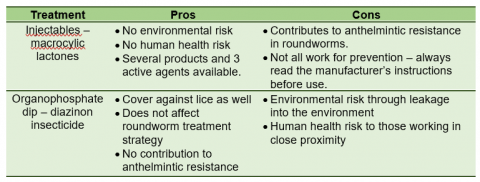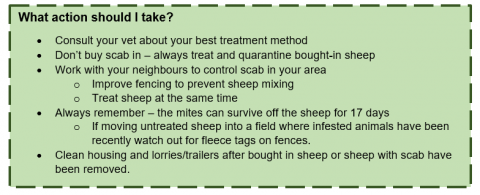Dr Ruth Wonfor: IBERS, Aberystwyth University
Take home messages:
- Sheep scab is caused by mites which live on the skin of the sheep, causing lesions, severe itching, loss of wool and ultimately a loss in production.
- All sheep with scab must be treated, but a correct diagnosis must be made first to avoid misdiagnosis with lice, for which treatment may be different.
- There are several treatments available, you should always consult your vet before treating.
- Sheep scab can be effectively controlled and prevented through strict biosecurity measures such as quarantining bought in sheep.
The Wales Animal Health and Welfare Framework sets out the plan for continuing and lasting improvements in standards of animal health and welfare for kept animals, whilst also helping to protect public health and making a contribution to the economy and the environment. Sheep Scab is a priority within the Wales Animal Health and Welfare Framework Implementation Plan 2016/17. More information is available at www.wales/ahwframework.
What is sheep scab?
Sheep scab is a highly contagious ectoparasite and a major health and welfare concern. Untreated sheep scab has severe effects on production and so, the efficiency of the flock is reduced. The infection is cause by a non-burrowing mite called Psoroptes ovis, which completes all four stages of its lifecycle on the sheep. One mite can lead to an infection that spreads throughout the flock and development in the sheep is extremely quick, with skin looking reddened 1 hour after exposure. Toxins in the mites’ faeces cause an allergic reaction in the sheep’s skin that is similar to human dermatitis. The affected area undergoes intense inflammation and disruption of the first layer of skin, essential for defence mechanisms.
Mites can persist on the animal without any evidence of the disease, often in the ear canal, resulting in spontaneous breakout in the future. Furthermore, mites also survive off the sheep in the environment for up to 17 days. So, although the primary mode of transmission is direct contact from sheep to sheep, if the mites are present in the environment, such as on fencing or in housing, the infection will persist within the flock. So how do we control this parasite?
Diagnosis
Scab can be spotted through observing clinical signs, such as intense itching, loss of wool, rubbing, licking, skin lesions and skin ulcers or abrasions (made worse by opportunist bacteria). In sheep with scab may also react to their skin being touched by protruding their tongue and nibbling, in severe cases that can cause seizures and death. Many signs related to scab are similar to lice infections, therefore treatment should never be completed based on observations alone. Accurate diagnosis is imperative to save time, money, unnecessary use of products and to prevent further damage to the health of the animal. Skin scrapings are used to confirm the presence of the mite by examination under a microscope. A recently developed ELISA diagnostic test determines the presence of antibodies to a specific mite toxin and so, is useful for diagnosis of scab before clinical signs develop, or for subclinical infections where mites are less likely detected through skin scraping. This will result in quicker and more targeted treatments. Moredun is also investigating the development of a pen-side test for rapid diagnosis.
Treatment
All sheep in the group or in a local area should be treated at the same time, especially those grazing common land. The whole flock should always be treated for scab if just one animal has mites. This may be more difficult in upland farms where stray sheep are found and an estimated 10% of the flock can be missed when gathering up. Considerations should be made as to where sheep are placed after treatment – will they come into contact with housing or fences that untreated sheep have been in contact with in the past 17 days? If so, there may still be mites present in the environment and so the treatment chosen must persist to prevent spread into newly treated animals.
Available treatments against sheep scab mites are either injectable macrocyclic lactone (ML) formulations or a diazinon dip. The MLs are broad spectrum anthelmintics, also used for treatment of roundworms. Care must be taken with their use to prevent encouragement of resistance in both mites and roundworms. There are several factors which should be considered when choosing a treatment, some of which are outlined in Table 2. Before making any treatment decisions, you should always discuss what to use with your vet.
Meat withdrawal periods should also be considered and adhered to, withdrawal periods may be doubled for organic producers, always check with your certification body prior to use. Therefore, in organic systems, the role of biosecurity and prevention of sheep scab is even more imperative. In all cases, even if one animal has scab the whole flock should be treated at the same time.
Table 2: Some of the pros and cons of the available treatments for sheep scab mites
Possible future control measures
Neither the current injectables or dip methods of treatment are sustainable due to development of resistance, therefore we need to think about alternative treatments or vaccines. Significant progress has been made in vaccine development, but more research and trials are needed before any product is brought to market. Work into treatment alternatives could focus on substances to stop the mites’ growth or biological control through essential oils or fungi. In the meantime we must concentrate on biosecurity measures to minimise the risk of spreading or contracting mites.
Control/Prevention
Make sure that sheep scab prevention is incorporated into your flock health plan, which should be developed with your vet. Remember that prevention is better than cure. Utilising a good biosecurity plan will help to protect against sheep scab.
Good biosecurity measures are imperative in the control of sheep scab on all farms, whether you have persistent or sporadic infections and especially if you have an organic flock. Risk factors for persistent scab are poor fencing and bought in sheep. It should be ensured that all fencing utilised is stock proofed to prevent livestock from neighbouring farms mixing, double fencing is best used where possible. In the case of common grazing land with a history of sheep scab, organisation of treatment of livestock between neighbours is essential to ensure all sheep in an area are treated at the same time. Removal of stray sheep from common grazing areas is also imperative in these areas.
Bought in sheep should always be treated and quarantined before introduction to the main flock. This is a practice not completed by many farms, but is best practice for the prevention of countless diseases entering your flock. Seek advice from your vet on how best to treat and quarantine any bought in sheep. For sheep scab specifically, following advised treatment, animals should be quarantined for at least 17 days and observed for any signs of scab.
Don’t forget that scab can survive off the animal for up to 17 days, whether this be on wool tags on fencing, housing, equipment, lorries, trailers, scanning races or other areas in the environment. Ideally if bought in sheep or those known to have scab are moved or treated, anything that the animals have come into contact with should be cleaned and left for 17 days before re-introducing treated or uninfected sheep. For example, if you have transported some bought in sheep to the quarantine area on your farm, you should thoroughly clean the vehicles and trailers that the sheep were transported in. After their quarantine period, you should then clean the housing and leave empty for a minimum of 17 days.
The UK Sheep Scab Order 1997 makes it illegal to leave sheep scab untreated and prevents the movement of affected animals. It would be beneficial for farms to work together in their neighbourhoods to make control of this parasite more economical and much easier. Sheep scab is a priority in Wales through the Animal Health and Welfare Framework (AHWF). As part of this work, a survey of farmers in Wales was carried out in 2016 to investigate the prevalence of scab in Wales. From this survey, geographical areas that have high scab risks will be identified and given further advice in control of mites. Further work will be completed through AHWF to update current recommendations for control of scab.
For more information on sheep scab see SCOPS and the HCC booklet on ‘Effective control of ectoparasites in sheep’. The Wales Animal Health and Welfare Framework sets out the plan for continuing and lasting improvements in standards of animal health and welfare for kept animals, whilst also helping to protect public health and making a contribution to the economy and the environment. Sheep Scab is a priority within the Wales Animal Health and Welfare Framework Implementation Plan 2016/17. More information is available on the Welsh Government website.



